Some Tips Before You Start Your
Australian Outback Travel
Australian Outback Travel
Australian outback travel can be an absolute blast and you will certainly see things you won't see anywhere else.
The wide open spaces and unique Aussie landscape is an experience you'll remember forever but if you are going to be travelling in the outback of Australia there are a few things you need to remember.
If you're just going to do the usual Australian outback travel thing and you're sticking mostly to the well travelled roads it's pretty simple just don't do anything stupid and you'll be fine.
Obviously that means no drinking and driving and no speeding, and the speeding can be pretty tempting in the bush because of the long travelling times and the long stretches of road.
You can check out our Driving in Australia page for some links, tips and general information.

Most of the suggestions below are more for the person that's going "off the beaten track" on their Australian outback travel holiday into the more unusual or little travelled places but some of them are for everyone travelling in the outback.
It's really bloody hot in the summer so keep your water intake up and stay out of the sun as much as you can, especially in the middle of the day, wear a hat, sunblock and a shirt to cover-up because you don't want to get sunstroke.
Our dad had a saying "only mad dogs and Englishmen go out in the midday sun" I'm not sure that's true but where's the Aussie? "in the pub"
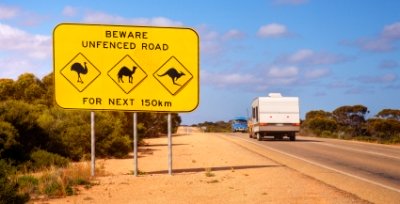
Wildlife Warning Signs Found On Australian Roads
Keep your eye out for the wildlife on your Australian outback travel, you don't want to hit anything because that can really put a spanner in the works but it can be just as bad or worse to swerve to miss an animal if you're travelling too quick; you'll see signs like this one all over Australia warning you to keep your eyes open for the animals.
Whenever possible avoid travelling at dusk, dawn and at night because that's the time you're more likely to see the kangaroos and other wildlife out and about and near the roads.
Now you might have heard a lot about the deadly wildlife in Australia but most of that is just hype, yes Australia does have poisonous snakes and creepy crawlies and bloody big crocodiles up north.
And you might see a few while you're on your great Australian outback travel adventure but so long as you don't step on the snakes you'll be right, believe me they like you even less than you like them and if you leave them alone they'll do the same for you.
Rule of thumb here is if it slithers or looks a bit creepy or scary just leave it alone mate!
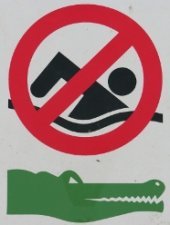
But now a bit of a warning about the
Australian Saltwater Crocodile.
The rule about "if you leave them alone they'll leave you alone" doesn't apply to crocodiles.
The stories you might have heard about them being aggressive and very dangerous is the absolute truth so please observe some rules if you're going to be travelling in crocodile areas.
Fortunately they only reside in the tropical far north so you don't have to worry if you're not travelling up there.
But if your Australian outback travel is taking you to the far north please understand attacks on humans do happen.
- Some people might think it's okay to swim in waters that are frequented by crocodiles but, in my opinion, that is just stupid.
- Observe the warnings and even if there aren't any signs don't assume that means no crocodiles.
- Stay well away from deep muddy waters because that's where they lurk.
- Don't walk too close to the edge of the water and always stand facing the water.
- They can jump to grab you so don't hang out over the water and assume that makes you safe.
- Saltwater crocodiles are opportunistic and territorial predators and they will observe you and learn your patterns so don't keep returning to the same spot at regular times because they will see that.
- Don't leave food scraps around or, and this should be obvious, don't bloody feed them otherwise you might be next on the menu.
Australia is a very big place and there can be very long distances between places in the bush so you need to keep that in mind while you're on your Australian outback holiday.
If you're looking for distance or directions just type the information into the calculator above and another window will open up and show you how to get there and how far it is.
Now before you set out on your Australian outback travel make sure you know the vehicle you're driving and how to drive it in the bush. You might think you're a great driver but if you've never driven on dirty dusty off the beaten track roads then you probably need to get some advice.
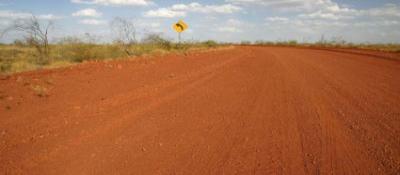
Australian Outback Road
Most outback roads are in fairly good condition but if they get used a lot they can "shake the shit out of you" with the heavy corrugation and that can not only hurt you but it can hurt your car too.
If the road is corrugated you will have to adjust your speed and if you've never been driving on these sort of roads before just take it easy.... You'll get there!
You might also want to take some shade with you, like a big umbrella, or better still, grab a tarp or two to string up and sit under when you stop and rest or if you break down and you have to wait awhile; it'll make your Australian outback travel holiday just a bit more pleasant.
Carry plenty of water with you.... I can't stress this point enough! It gets hot in the bush and even if you think you'll be getting to the next stop in good time, unexpected things can happen and you're better off being safe, so stock up on the water! About 8 to 10 litres per person should be good, it might seem like a lot but if the unexpected does happen you'll be right.
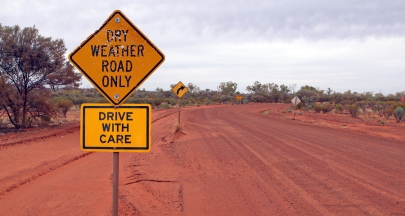
Dry Weather Road Only Sign - With A Few Bullet Holes
Always find out what to expect from the road conditions and how the weather has been recently. Get advice from a local on the best route to take and how things are going and make sure you are driving the appropriate vehicle (you don't want to take a little city car into 4wd country).
Always tell someone where you are going, including the route you are going to take, and when you expect to be there, that way if you are running late they can let the appropriate authorities know if you are overdue.
If you do break down in the bush.... Stay with your vehicle do not attempt to walk out of the bush on your own. You will be easier to find if you stay by your vehicle.
If your Australian outback travel is going to be for an extended period you may need to carry extra provisions like extra petrol, an extra spare tyre, motor oil, a spare fan belt and even more water but you need to find out if this is necessary when you decide on the trip you're taking; you can ask a local or the person who arranges the holiday for you.
Carry a mobile phone with you and make sure it's on a network that's going to work in the bush but don't rely on that completely because there might still be places you are going where it won't work, if you want to be absolutely positive take a satellite phone and an emergency beacon that way if you do wander off your planned track and something goes wrong you can let someone know, get some help and get back on the road.
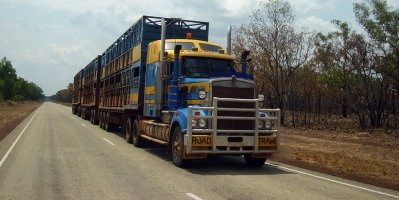
Australian Road Trains Seen In The Outback
A common sight you'll see on your outback travel will be the Australian road trains, they're multiple trailer trucks and sometimes passing them can get a bit tricky but as with passing any vehicle in the outback the key is to pay attention, be patient, be courteous and act quickly when you do decide to make the pass and make sure you give yourself plenty of room to do so.
Quite often the driver of the road train will indicate to you it's safe to pass by flicking on his right hand indicator, when you see this you need to pass as quickly and safely as possible, you want to spend the least amount of time on the other side of the road as you can; give the driver a wave when you've finished passing to show your thanks.
If you're passing on dirt roads it's a little different, if you see a cloud of dust coming towards you slow down and when they get closer move as far as you can to the left side of the road, the other driver should do the same.
If you see a cloud of dust in your rearview mirror and someone is coming up to pass you from behind you should slow down so they can see when it's safe to do so and if it's you passing someone in front you should also slow down while doing so to minimize the rocks that will get thrown up at them, if it's safe you should stay on the wrong side of the road for a bit and then move back.
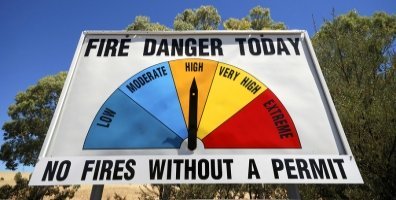
Australian Fire Danger Index Sign
Please observe the fire warnings in Australia, keep yourself informed about the particular warnings where you are or where you're going and observe them; all it takes is a cigarette carelessly thrown out of a window or a fire not put out properly to start a bushfire.
The Australian Bureau Of Meterology National Warnings Summary page provides up to date information for all Australian weather warnings.
If you want to enter Aboriginal land on your travels you may need a permit; you can find out more from The Northern Land Council frequently asked questions page.
The best way to see and explore this wide open land of ours is by hiring a vehicle and driving around yourself.
You can check out the cost and availability of cars right here on our site.... Click Here and you will be taken to another page so you can put in all the details and hit the search button.
And remember to be friendly and courteous to the people you meet or encounter while on your Australian outback travel because the attitude you have in the bush could make all the difference if you need any help.
Quite often people passing in the bush will give you a wave, you'll see it as you go round, give them a wave back and enjoy your great Australian outback travel adventure.
Go On To Backpacking Australia page
Return to Travel To Australia Guide
Return from Australian Outback Travel to Australian-Information-Stories home page


